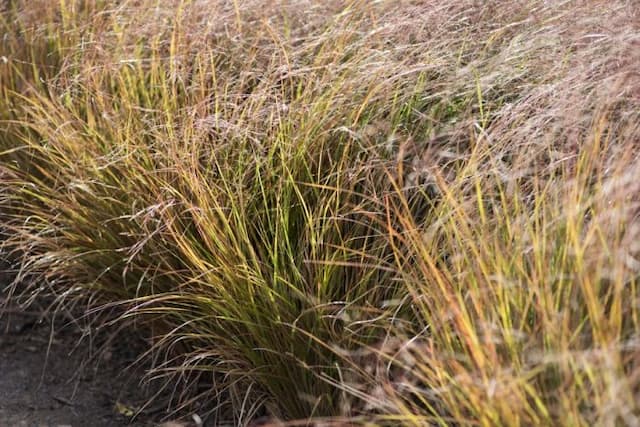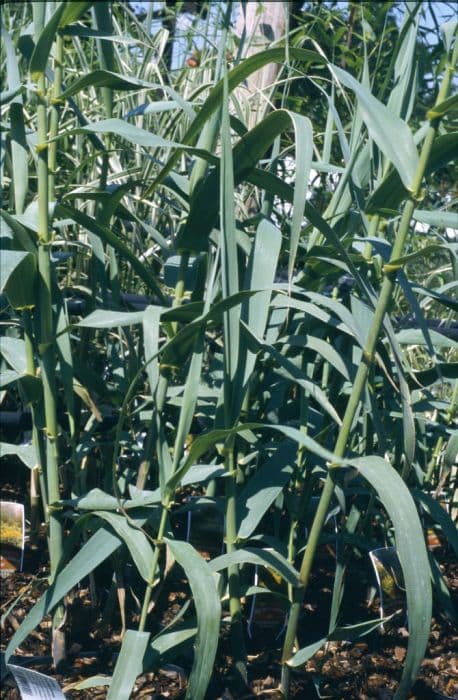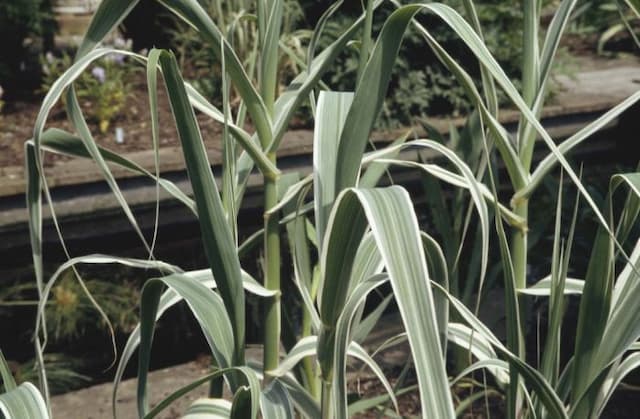Chinese Silver Grass Miscanthus sinensis 'Septemberrot'











ABOUT
The plant known as Chinese silver grass 'Septemberrot' is a striking perennial grass that boasts a lush, clumping habit. Its name translates to 'September red,' hinting at the distinctive color it takes on during the fall. The foliage consists of slender, arching leaves with a deep green hue that transitions to a striking reddish color as the cooler weather sets in, offering a rich display of autumnal color. Come late summer to early autumn, Chinese silver grass 'Septemberrot' produces feathery flower plumes. These plumes emerge in a reddish-pink tone, adding a soft, airy texture above the foliage, and eventually fade to a silvery white as they mature, providing visual interest well into the winter months. The plant's overall form is gracefully upright yet maintains a sense of fullness and density. This visual texture and color change make it an attractive addition to any garden space seeking to exhibit seasonal variation. Chinese silver grass 'Septemberrot' is not only appreciated for its ornamental qualities but also for its ability to create a natural screen or backdrop in landscape designs due to its form and foliage. It can thrive in a variety of conditions and is often seen swaying gently in the breeze, contributing movement and dynamism to the garden setting.
About this plant
 Names
NamesFamily
Poaceae
Synonyms
Chinese Silver Grass, Maiden Grass, Eulalia, Zebra Grass, Japanese Silver Grass, Porcupine Grass.
Common names
Miscanthus sinensis 'Septemberrot'.
 Toxicity
ToxicityTo humans
Maidenhair grass, commonly known as Miscanthus sinensis 'Septemberrot', is not considered to be toxic to humans. In most cases, handling or ingesting this plant should not cause any symptoms of poisoning. However, caution should be exercised as individuals may have varying sensitivities to different plants.
To pets
Maidenhair grass, commonly known as Miscanthus sinensis 'Septemberrot', is also not considered to be toxic to pets. It should not cause poisoning or harmful effects if pets ingest parts of the plant. As with humans, it is always best to supervise pets around plants and discourage them from eating ornamental vegetation as individual animals may have different reactions.
 Characteristics
CharacteristicsLife cycle
Perennials
Foliage type
Deciduous
Color of leaves
Green
Flower color
Red
Height
4-7 feet [1.2-2.1 meters]
Spread
2-4 feet [0.6-1.2 meters]
Plant type
Grass
Hardiness zones
4-9
Native area
Asia
Benefits
 General Benefits
General Benefits- Ornamental Value: Adds aesthetic appeal to gardens with its reddish-pink plumes and arching foliage.
- Drought Tolerance: Once established, it can withstand periods of low water availability, making it suitable for xeriscaping.
- Seasonal Interest: Provides visual interest throughout the seasons, from spring green shoots to autumn's copper tones and winter's structural form.
- Privacy Screen: Grows densely, which can be used to create a natural privacy barrier or windbreak in landscapes.
- Erosion Control: Its root system stabilizes soil and can help prevent erosion on slopes or banks.
- Low Maintenance: Requires minimal care once established, with little need for fertilization or pruning.
- Wildlife Attraction: Can attract birds which use the plant for cover and the seeds for food.
- Adaptability: Tolerates a range of soil types and conditions, from acidic to alkaline and from clay to sandy soils.
- Longevity: As a perennial, it comes back year after year, reducing the need for yearly replanting.
- Hardiness: Can survive in a wide range of climates and is resilient to many pests and diseases.
 Medical Properties
Medical PropertiesThis plant is not used for medical purposes.
 Air-purifying Qualities
Air-purifying QualitiesThis plant is not specifically known for air purifying qualities.
 Other Uses
Other Uses- Miscanthus sinensis 'Septemberrot', commonly known as Maiden Grass, can be woven into lightweight panels for partitioning indoor spaces, allowing for aesthetically pleasing, natural room dividers.
- Maiden Grass is utilized in the crafting of traditional musical instruments in East Asian countries, where its reeds are used for creating flute-like wind instruments.
- In ornamental horticulture, Maiden Grass can be used as a natural dye source for fabrics, imparting a subtle, earthy tone to textiles.
- Landscape artists often use dried Maiden Grass in their installations to add texture and a sense of movement due to its feathery plumes and tall structure.
- It can serve as biofuel; owing to its fast growth rate and high biomass yield, Maiden Grass has been researched as a sustainable source of energy when converted into bioethanol.
- Maiden Grass is sometimes incorporated into thatched roofing materials in traditional building techniques for its insulative properties and natural appearance.
- In some cultures, the plant is used in Feng Shui garden designs for its aesthetic features that are believed to attract positive energy.
- Fine papermaking—an ancient craft in Japan, known as "washi"—occasionally utilizes fibers from Maiden Grass to create high-quality, textured paper products.
- Maiden Grass can be used to create biodegradable garden pots, providing an eco-friendly alternative to plastic containers.
- The dense growth of Maiden Grass can be optimized as a natural barrier to reduce noise pollution in urban and suburban settings.
Interesting Facts
 Feng Shui
Feng ShuiThe plant Miscanthus is not used in Feng Shui practice.
 Zodiac Sign Compitability
Zodiac Sign CompitabilityThe plant Miscanthus is not used in astrology practice.
 Plant Symbolism
Plant Symbolism- Resilience: Miscanthus sinensis 'Septemberrot', commonly known as Chinese silver grass, is known for its ability to adapt to a variety of climates and soil types, reflecting the symbolic meaning of resilience and adaptability.
- Growth: As a perennial grass that grows back stronger year after year, it symbolizes continuous growth and the ability to overcome challenges.
- Flexibility: The slender and flexible blades of Chinese silver grass move gracefully in the wind, symbolizing flexibility and the ability to bend without breaking in the face of adversity.
- Privacy: Often used as a screen or hedge in landscaping, it symbolizes the desire for privacy or the act of protection against invasive eyes.
- Timelessness: With its long season of beauty from summer to winter, Chinese silver grass represents the concept of timelessness and enduring presence.
 Water
WaterWater Maiden Grass deeply to ensure a good soak, aiming to provide about 1 inch of water weekly. When established, it's quite drought-tolerant but performs best with consistent moisture. During the growing season, if there's no rain, water once a week. In the winter or during periods of rainfall, reduce watering frequency. Generally, for an established clump in the garden, about a gallon of water weekly should suffice unless conditions are very dry.
 Light
LightMaiden Grass thrives in full sunlight but can tolerate partial shade. Ideally, position it in a spot where it can receive at least 6 hours of direct sunlight daily. It is adaptable, but too much shade can lead to a lack of flowers and a floppy habit.
 Temperature
TemperatureMaiden Grass prefers temperatures in the range of 50°F to 90°F but can tolerate down to about -20°F once established. It's hardy and can survive winter cold, but may not thrive in prolonged periods of extreme heat above 90°F.
 Pruning
PruningPrune Maiden Grass back to about 4-6 inches from the ground in late winter or early spring before new growth starts. Pruning promotes healthy growth and prevents the plant from becoming too woody. The best time for pruning is just before the last expected frost date in your area.
 Cleaning
CleaningAs needed
 Soil
SoilChinese Silver Grass thrives in a well-draining soil mixture, ideally a loamy composition with some organic matter to retain moisture yet allow excess water to drain. The best soil pH for Chinese Silver Grass 'Septemberrot' is slightly acidic to neutral, ranging from 5.5 to 7.2.
 Repotting
RepottingChinese Silver Grass, being a large and hardy perennial, does not require frequent repotting. It should generally be repotted or divided every few years as needed to manage its size or refresh the soil.
 Humidity & Misting
Humidity & MistingChinese Silver Grass is tolerant of a wide range of humidity levels and does not require specific humidity conditions for optimal growth, making it quite adaptable to different outdoor environments.
 Suitable locations
Suitable locationsIndoor
Not suitable for typical indoor growth; requires outdoor setting.
Outdoor
Plant in full sun, well-draining soil; doesn't need special care.
Hardiness zone
Chinese Silver Grass 'Septemberrot' is suitable for USDA zones 4-9.
 Life cycle
Life cycleMiscanthus sinensis 'Septemberrot', commonly known as Chinese Silver Grass or Maiden Grass, begins its life cycle as a seed, which germinates in late spring when soil temperatures warm up. The seedling emerges and grows rapidly, developing long, slender leaves and a robust root system. Throughout the summer, the grass reaches maturity and produces distinctive feathery flower plumes, which start off pinkish-red, giving the cultivar 'Septemberrot' its name, before fading to a silver-grey. In the fall, leaves may turn an attractive coppery or reddish color adding to the ornamental appeal of the plant. With the onset of winter, the above-ground parts of the plant die back to the ground, but the roots remain viable and store energy for the following year's growth cycle. In early spring, new growth resumes from the root system, continuing the perennial life cycle of the plant.
 Propogation
PropogationPropogation time
Late Winter-Early Spring
The most popular method of propagating Miscanthus sinensis 'Septemberrot', commonly known as Chinese silver grass, is through division. The best time to propagate by division is in late winter to early spring, before new growth begins. To propagate, first, dig up a mature clump of the grass, ensuring to get a good portion of the root system. Using a sharp spade or knife, divide the clump into smaller sections, each with several shoots and a portion of the root system. Replant these divisions at the same depth they were originally growing, spacing them about 3 feet (approximately 0.91 meters) apart to allow room for growth. After planting, water the divisions thoroughly to help establish them in their new location.









